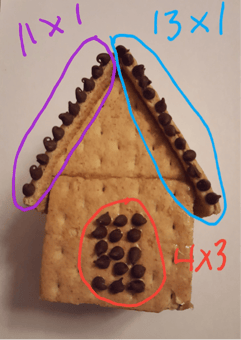1.800.221.5175
Mathematics
Sadlier PreK with Wiley Blevins
Knowledge-Building Early Childhood Program
Preview
|
Progress Mathematics
Grades K–8
Reading & Writing
From Phonics to Reading
Grades K–3
Building Reading Success with Wiley Blevins
Grades K–5
Sadlier PreK with Wiley Blevins
Knowledge-Building Early Childhood Program
Preview
|
Vocabulary
Vocabulary Workshop, Tools for Comprehension
Grades 1–5
Vocabulary Workshop Achieve
Grades 6–12+
|




 This photo shows the relative size of the small and big houses. The smaller gingerbread house uses seven graham crackers. The large structure uses sixteen graham crackers, including some on the inside in order to provide stability.
This photo shows the relative size of the small and big houses. The smaller gingerbread house uses seven graham crackers. The large structure uses sixteen graham crackers, including some on the inside in order to provide stability. 

 This picture shows how arrays can be used to decorate the house. The door is a 5 x 3 array while the eaves of the house have a 13 x 1 array and a 11 x 1 array. The door is an example of a composite number array, while the eave decorations are examples of prime number arrays. In Grades 2 or 3, you could just use arrays to make doors, windows, or trim, but beginning in Grade 4, the idea of prime and composite numbers is introduced and would be good to use through the end of middle school. This is an example of how the activity can be differentiated for the various grade levels.
This picture shows how arrays can be used to decorate the house. The door is a 5 x 3 array while the eaves of the house have a 13 x 1 array and a 11 x 1 array. The door is an example of a composite number array, while the eave decorations are examples of prime number arrays. In Grades 2 or 3, you could just use arrays to make doors, windows, or trim, but beginning in Grade 4, the idea of prime and composite numbers is introduced and would be good to use through the end of middle school. This is an example of how the activity can be differentiated for the various grade levels.